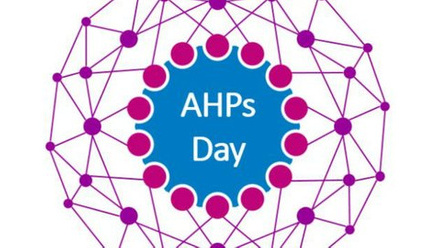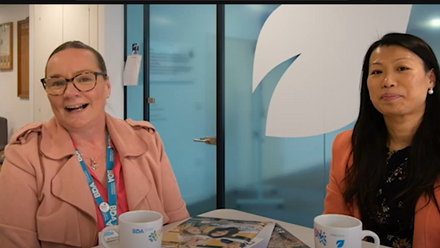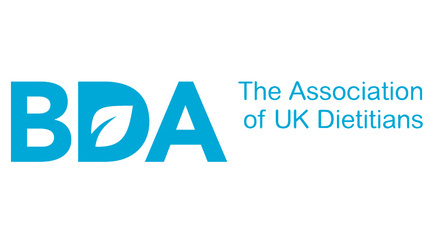The importance of dietetic input on an acute stroke ward is well-recognised: dysphagia is prevalent(1- see references below) and an association exists between malnutrition and mortality, hospital length of stay and hospitalisation costs at six months post-stroke.2 After discharge from hospital, patients requiring ongoing dietetic input may be triaged into general clinics, but there may be benefits of dietetic input within a community stroke rehabilitation team (CSRT).
I have worked with a CSRT (0.4wte, two days weekly) for the past three years alongside my role as an acute stroke specialist dietitian (0.6wte, three days weekly). The CSRT is a stroke specialist multi-professional team incorporating dietetics, occupational therapy, nursing, physiotherapy and speech & language therapy (SALT). The geographical area I cover is 16 x 9 miles, and I typically have 15-25 patients on my caseload.
"I have a better understanding of the roles of other healthcare professionals and how social care is coordinated”
Poor nutritional intake, weight loss, and feeding and swallowing problems can persist for many months post-stroke3,4,5. Many post-stroke impairments can affect nutrition – for example, dysphagia and texture modified diet and fluids, confusion, limb weakness preventing self-feeding and food preparation, visual problems, depression, and cognitive impairment affecting memory and concentration. The National Clinical Guideline for Stroke6 recommends that stroke survivors with ongoing problems meeting their nutritional needs should have their dietary intake and nutritional status monitored regularly.
Dietetic input
After discharge from hospital following a stroke, patients with ongoing therapy needs are referred to the CSRT. The team aims to have face-to-face contact with patients within 48 hours of receiving their referral. At this initial “screen” assessment, patients are asked about nutritional problems including malnutrition and scope to provide secondary prevention advice. Areas relating to medication, housing, mobility, vision, mood, communication and continence are also explored. From here, referrals to various members of the team are made.
If a patient is referred to dietetics, I aim to see patients within 14 working days at their own home. My caseload usually comprises of 50% nutrition support and 50% weight management or secondary prevention advice. Advice regarding nutrition support might involve food first advice, requesting prescriptions of nutritional supplements, and managing gastrostomy feeding for supplemental or exclusive nutrition. Lifestyle information relevant to secondary prevention of stroke includes smoking cessation, physical activity, alcohol, and stress management. Good knowledge of local occupational activities, exercise programmes and mental health schemes are vital to ensure patients are signposted to appropriate services.
One of the most common issues which patients discuss with me is taste changes, which can lead to reduced oral intakes and weight loss. I have found that stroke-related depression can also be a barrier to adhering to secondary prevention advice. Service development activities I’ve been involved in include updating colleagues at in-service training sessions regarding appropriate referrals, basic food first nutrition support advice and education about healthy eating and cardio-protective diets.
Non-diet specific roles
Working in the CSRT has provided opportunities to partake in activities and assessments outwith the typical
dietitian role. These include completing Patient Health Questionnaire-9 (PHQ-9) forms with patients whose moods are low, completing outcome measures like the Nottingham Extended Activities of Daily Living (NEADL) scale and Barthel Index, and measuring and interpreting blood pressure.
Completing the initial screen (ideally within 48 hours post-discharge) means that physiotherapy, occupational therapy, nursing and speech and language therapy needs are considered. My awareness of non-dietetic related complications like visual, communication, cognitive, continence, and seating problems is much better since working in the CSRT. I feel that I have a better understanding of the roles of other healthcare professionals and how social care is coordinated in the community.
Outcome measures
I try to use a tool from the Therapy Outcome Measures for Rehabilitation Professionals
(TOMs)7 book when looking at secondary prevention for stroke in the community. I find that “Dietetic Intervention for the Prevention of Cardiovascular Disease” tool works well for the types of stroke patients I typically see. As a team, we use the “Stroke” tool from the same publication, but it is useful to look at dietetic outcomes separately to measure effectiveness of dietetic input, and help identify specific barriers or inefficiencies within the service. The Dietetic Outcomes Toolkit8 is a useful resource for those hoping to learn more about reporting outcomes.
Challenges and job satisfaction
At times I encounter a lack of engagement from patients to make dietary changes when other aspects of stroke recovery (increasing mobility, improving speech, etc) are a higher priority to them. Motivational interviewing has been a helpful tool to help promote change, as well as presenting dietary changes as a modifiable risk factor for stroke. Health inequalities impact patients who I see – the area in which I work is deprived in parts and it has poor outcomes relating to smoking, alcohol and obesity9. The area also scores worse than England averages for hypertension, atrial fibrillation and diabetes which are risk factors for stroke.
Job satisfaction can be excellent, especially when I have been involved in a patient’s stroke journey from when they get admitted to hospital right through to their rehabilitation. Often I get to know patients and their families very well, and I have been told that it is reassuring for family members/carers see a familiar face once a patient is discharged home. From an efficiency point of view, I have good awareness about what happened during the inpatient admission and this saves time trawling through medical records and dietetic notes. Joint home visits with SALT have improved my knowledge of the role of the SALT in the community, and it can be very useful to discuss post-stroke dysphagia and dietetic advice in conjunction with each other to ensure the advice we give is consistent. In my opinion, the process of successfully weaning patients off gastrostomy feeding and progressing with oral diet is the most rewarding part of the job, and this is a joint effort between dietetics and SALT.
Once patients are discharged from all of the other members of the CSRT but still require dietetic input, I hand them over to the community dietetic services for ongoing monitoring. Dietetic input within a CSRT is a great example of how dietitians can work in an integrated team, adhere to guidance outlined in the RCP National Clinical Guideline for Stroke and hopefully contribute to improved stroke outcomes in the community.
References:
1. Martino, R, Foley N, Bhogal, S, Diamant, N, Speechley M, Teasell, R. Dysphagia after stroke: incidence, diagnosis, and pulmonary complications. Stroke. 2005;36(12): 2756-2763
2. Gomes F, Emery, PW, Weekes, CE. Risk of malnutrition is an independent predictor of mortality, length of hospital
stay, and hospitalization costs in stroke patients. Journal of Stroke and Cerebrovascular Diseases. 2016;25(4): 799-806.
3. Finestone HM, Woodbury MG, Foley NC, Teasell RW, Greene-Finestone LS. Tracking clinical improvement of swallowing disorders after stroke. Journal of Stroke & Cerebrovascular Diseases. 2002;(11): 23-7.
4. Jonsson AC, Lindgren I, Norrving B, Lindgren A. Weight loss after stroke: a population-based study from the Lund Stroke Register. Stroke. 2008;(39): 918-23.
5. Perry L. Eating and dietary intake in communication-impaired stroke survivors: a cohort study from acute-stage hospital admission to 6 months post-stroke. Clinical Nutrition. 2004;(23): 1333-43.
6. Royal College of Physicians (RCP), National clinical guideline for stroke. 5th Edition. Intercollegiate Stroke Working Party. 2016. Available from: https://www. strokeaudit.org/SupportFiles/Documents/Guidelines/2016-National-Clinical-Guideline-for-Stroke-5t-(1).aspx.
7. Enderby P, John A. Therapy Outcome Measures for Rehabilitation Professionals. 3rd Edition. UK: J&R Press. 2015.e
8. British Dietetic Association’s Parenteral and Enteral Nutrition Group (PENG). The Dietetic Outcomes Toolkit. 2016. Available from: https://www.peng.org.uk/pdfs/publications/dietetic-outcomes-toolkit.pdf.
9. Sunderland City Council. Health Needs Summary. 2019. Available from: https://www.sunderland. gov.uk/media/22055/Health-Needs-Summary-2018-2019/pdf/Health_needs_summary_2018-19_ updated_September_2019.
pdf?m=637109767241100000





